Crosshatching, a technique that has become synonymous with the art of drawing and engraving, boasts a rich and varied history that stretches back to ancient civilisations. Its origins can be traced to the early days of human expression, where artists sought to create depth and texture in their work. The technique was notably employed by the ancient Egyptians, who used it in their hieroglyphics and wall paintings to convey shadows and dimensionality.
As time progressed, crosshatching evolved through the Renaissance, a period marked by a renewed interest in realism and the human form. Artists such as Albrecht Dürer and Leonardo da Vinci harnessed the power of crosshatching to create intricate details and lifelike representations, pushing the boundaries of what could be achieved with mere lines on paper. The 17th and 18th centuries saw crosshatching flourish in the realm of printmaking, particularly in etching and engraving.
Artists like Rembrandt van Rijn and Francisco Goya utilised this technique to add depth and richness to their prints, creating works that were not only visually striking but also emotionally resonant. The interplay of light and shadow achieved through crosshatching allowed these artists to explore complex themes and narratives within their work. As the 19th century approached, the advent of lithography introduced new possibilities for crosshatching, enabling artists to experiment with different styles and approaches.
This period marked a significant turning point, as crosshatching became a fundamental technique in various artistic movements, including Impressionism and Post-Impressionism, where artists began to incorporate it into their paintings, further solidifying its place in the annals of art history.
Summary
- Crosshatching has been used in art for centuries, with evidence of its use dating back to the 15th century.
- The technique involves creating a series of parallel lines that intersect at various angles to create shading and texture in drawings.
- To start crosshatching, artists will need paper, pencils, pens, and markers, with different materials producing different effects.
- There are various styles and approaches to crosshatching, including traditional, expressive, and experimental techniques.
- Tips for mastering crosshatching include practicing different line weights, experimenting with different angles, and studying the work of famous artists known for their crosshatching skills.
Understanding the Technique of Crosshatching
At its core, crosshatching is a method of shading that involves drawing parallel lines in overlapping patterns to create tonal variations and textures. The technique relies on the careful placement of lines to suggest light, shadow, and form, allowing artists to manipulate the viewer’s perception of depth. By varying the density and direction of the lines, an artist can achieve a wide range of effects, from soft gradients to stark contrasts.
This versatility makes crosshatching an invaluable tool for artists seeking to convey emotion and atmosphere in their work. Understanding the fundamental principles behind crosshatching is essential for anyone looking to master this technique; it requires not only technical skill but also a keen eye for observation. To effectively utilise crosshatching, artists must consider several factors, including line weight, spacing, and direction.
Thicker lines can create a sense of boldness or emphasis, while finer lines may evoke delicacy or subtlety. The spacing between lines also plays a crucial role; closer lines can produce darker areas, while wider spacing results in lighter tones. Additionally, the direction of the lines can influence the overall composition; diagonal lines may suggest movement or dynamism, while horizontal or vertical lines can impart stability or calmness.
By experimenting with these elements, artists can develop their unique style and approach to crosshatching, allowing for personal expression within this traditional technique.
Materials Needed for Crosshatching

To embark on a journey into the world of crosshatching, one must first gather the appropriate materials that will facilitate this intricate art form. The choice of medium is paramount; traditional options include graphite pencils, ink pens, and charcoal. Each medium offers distinct qualities that can enhance the crosshatching process.
Graphite pencils are particularly favoured for their versatility and ease of use, allowing artists to create fine lines as well as broader strokes with varying pressure. Ink pens, on the other hand, provide a more permanent solution that can yield crisp, clean lines ideal for detailed work. Charcoal offers a softer approach, enabling artists to achieve rich textures and dramatic contrasts.
In addition to the drawing instruments themselves, the choice of paper is equally important in achieving successful crosshatching results. A heavier weight paper with a textured surface can hold ink or graphite more effectively, allowing for greater control over line quality. Some artists prefer smooth paper for fine detail work, while others may opt for rougher surfaces that lend themselves well to expressive strokes.
Furthermore, having an eraser on hand is essential for refining lines and correcting mistakes during the process. Ultimately, the materials chosen will significantly influence the outcome of a crosshatched piece; therefore, artists should experiment with various combinations to discover what best suits their style and vision.
Different Styles and Approaches to Crosshatching
Crosshatching is not a monolithic technique; rather, it encompasses a myriad of styles and approaches that reflect the diverse backgrounds and intentions of artists throughout history. One prominent style is the traditional method employed by engravers during the Renaissance period. This approach often features tightly packed lines that create intricate patterns and textures, resulting in highly detailed images that draw viewers in for closer inspection.
Artists like Dürer exemplified this style through their meticulous attention to detail and mastery of line work. In contrast, contemporary artists may adopt a more expressive approach to crosshatching, using looser lines and varied spacing to evoke emotion or movement within their compositions. Another fascinating aspect of crosshatching is its adaptability across different artistic movements.
For instance, Impressionist artists often incorporated crosshatching into their works to capture fleeting moments of light and colour. This technique allowed them to convey the essence of a scene rather than its precise details. Similarly, modern graphic novelists and illustrators have embraced crosshatching as a means of adding depth and character to their illustrations.
By blending traditional techniques with contemporary themes and narratives, these artists continue to push the boundaries of crosshatching, demonstrating its enduring relevance in the ever-evolving landscape of art.
Tips and Tricks for Mastering Crosshatching
Mastering crosshatching requires practice and patience; however, there are several tips and tricks that can help aspiring artists refine their skills more efficiently. One effective strategy is to start with simple shapes before progressing to more complex forms. By practising on basic objects such as spheres or cubes, artists can focus on understanding how light interacts with different surfaces while honing their line work.
Additionally, studying the works of master artists who have successfully employed crosshatching can provide valuable insights into effective techniques and approaches. Another crucial aspect of mastering crosshatching is developing a consistent hand movement and pressure control. Artists should experiment with varying degrees of pressure on their drawing instruments to achieve different line weights and textures.
Practising slow, deliberate strokes can help build muscle memory while allowing for greater control over line placement. Furthermore, incorporating breaks during drawing sessions can prevent fatigue and maintain focus on achieving precision in line work. Ultimately, persistence is key; by continually challenging oneself and seeking out new techniques or styles within crosshatching, artists can cultivate their unique voice within this timeless art form.
Famous Artists Known for Using Crosshatching

Throughout art history, numerous renowned artists have made significant contributions to the development and popularisation of crosshatching as a technique. One such figure is Albrecht Dürer, whose engravings are celebrated for their intricate detail and masterful use of line work. Dürer’s ability to create depth through crosshatching set a standard for future generations of artists.
His works often featured elaborate backgrounds filled with meticulously rendered foliage or architectural elements that showcased his command over this technique. Dürer’s influence extended beyond his lifetime; many artists sought to emulate his style while incorporating their unique interpretations. Another prominent artist known for his use of crosshatching is Rembrandt van Rijn.
His etchings are characterised by dramatic contrasts between light and shadow achieved through skillful layering of lines. Rembrandt’s ability to convey emotion through his subjects was enhanced by his adept use of crosshatching; he often employed this technique to create atmospheric portraits that captured the essence of his sitters. His innovative approach inspired countless artists who followed in his footsteps, solidifying crosshatching’s place as an essential tool in portraiture and narrative art.
Crosshatching in Contemporary Art
In contemporary art, crosshatching continues to thrive as both a traditional technique and a modern expression of creativity. Many contemporary artists have embraced this method while infusing it with new ideas and themes relevant to today’s society. For instance, some utilise crosshatching in mixed media works that combine drawing with painting or digital elements, creating dynamic compositions that challenge conventional boundaries between different art forms.
This fusion allows for greater experimentation with texture and depth while maintaining the integrity of traditional techniques. Moreover, contemporary graphic novelists have adopted crosshatching as a vital component of visual storytelling. Artists such as David Mazzucchelli have demonstrated how effective line work can enhance narrative elements within comics by adding emotional weight or atmosphere to scenes.
The versatility of crosshatching enables these creators to convey complex ideas succinctly while engaging readers visually. As contemporary art continues to evolve alongside technological advancements, it is likely that crosshatching will remain an integral part of artistic expression across various mediums.
Exploring the Versatility of Crosshatching in Different Art Forms
The versatility of crosshatching extends beyond traditional drawing or printmaking; it has found its way into various art forms such as illustration, animation, sculpture, and even textile design. In illustration, artists often employ crosshatching techniques to create detailed character designs or intricate backgrounds that enhance storytelling elements within books or magazines. This method allows illustrators to convey mood effectively while maintaining clarity in their visuals.
In animation, crosshatching has been used stylistically to evoke nostalgia or mimic traditional hand-drawn techniques within digital platforms. Animators may incorporate this method into character designs or backgrounds to create a unique aesthetic that resonates with audiences familiar with classic animation styles. Furthermore, textile designers have begun exploring how crosshatching can inform fabric patterns through repetition and variation in line quality—resulting in textiles that possess both visual interest and tactile appeal.
In conclusion, crosshatching is not merely a technique confined to historical contexts; it remains an enduring practice that continues to inspire artists across generations and disciplines alike. Its rich history intertwined with evolving styles showcases its adaptability while highlighting its significance within contemporary art practices today.
For those intrigued by the meticulous art technique of crosshatching, exploring various art styles and techniques can further enrich one’s understanding and appreciation of the diverse methods artists employ. A recommended read is An Introduction to the Painting ‘Caress of the Sphinx, 1896’ by Fernand Khnopff, which delves into the symbolist approach of Khnopff. This article provides insights into how different techniques and thematic elements can evoke varied emotional responses, offering a broader perspective on the artistic landscape that includes crosshatching among other methods.




